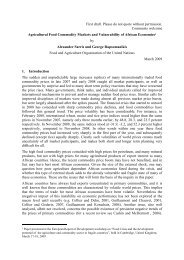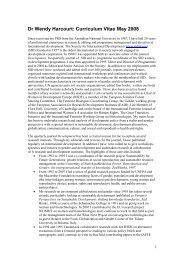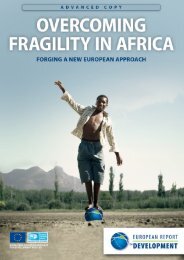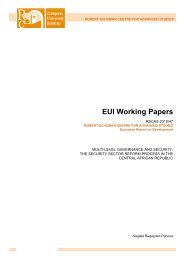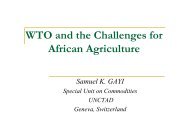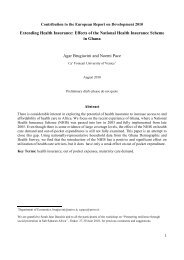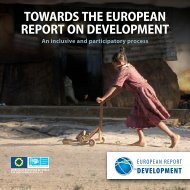LiveLihoods strategies and househoLd resiLience to Food insecurity ...
LiveLihoods strategies and househoLd resiLience to Food insecurity ...
LiveLihoods strategies and househoLd resiLience to Food insecurity ...
Create successful ePaper yourself
Turn your PDF publications into a flip-book with our unique Google optimized e-Paper software.
LIVELIHOODS STRATEGIES AND HOUSEHOLD RESILIENCE TO FOOD INSECURITY: AN EMPIRICAL ANALYSIS TO<br />
KENYA<br />
government, firms, <strong>and</strong> remittances. Then, we st<strong>and</strong>ardised it, in order <strong>to</strong> have a latent<br />
variable with zero mean <strong>and</strong> variance equal <strong>to</strong> 1, before running the second stage fac<strong>to</strong>r<br />
analysis <strong>to</strong> estimate resilience. In this case, wage-employees show the highest level of<br />
SSN while pas<strong>to</strong>ralists <strong>and</strong> small-holder farmers the lowest level (Table 10).<br />
Table 10: Average values of the SSN component<br />
Variables Kenya<br />
Agropas<strong>to</strong>ral<br />
ists<br />
Smallholder<br />
farmers<br />
Largeholder<br />
farmers<br />
Entrepr<br />
e-neurs<br />
Wage<br />
employe<br />
es<br />
Pas<strong>to</strong>rali<br />
sts<br />
SSN 1,117.6 985.0 660.1 944.2 1,197.9 2,055.4 242.6<br />
Stability (S)<br />
Stability is an important dimension of household’s resilience that captures the degree <strong>to</strong><br />
which household’s options vary over time. To estimate the value of this latent variable,<br />
we used the value of losses due <strong>to</strong> shocks, namely:<br />
• animal shock (ANS): the value-loss due <strong>to</strong> s<strong>to</strong>len or dead lives<strong>to</strong>ck;<br />
• crop shock (CRS): this is the crop loss caused by droughts, floods, crop diseases,<br />
pest outbreaks, fall in output prices, increase in input prices, <strong>and</strong> water shortages;<br />
• other shocks (OTS): this variable summarises the value loss due <strong>to</strong> shocks other than<br />
those considered in the previous two variables (for example, the illness, death, job<br />
loss of a household member);<br />
• shocks (SHK): this is a count variable constructed as the sum of the dummy<br />
variables which indicate whether a household was hit or not by each shock typology<br />
during the five years before the survey.<br />
Clearly, a given monetary loss does not have the same meaning for all<br />
households. Thus, we decided <strong>to</strong> normalise the first three variables by dividing each of<br />
them for household per capita expenditure. Each observed shock variable is, indeed, an<br />
indica<strong>to</strong>r of instability. Thus, we multiplied each of them times -1 in order <strong>to</strong> make them<br />
consistent with the meaning of the latent variable S.<br />
Table 11 shows that the most stable livelihood groups are wage-employees <strong>and</strong><br />
large-holder farmers, while small-holder farmers are those who are relatively the least<br />
stable.<br />
Table 11: Fac<strong>to</strong>r loadings for the observed variable used <strong>to</strong> estimate the S<br />
component<br />
Variables Kenya<br />
Agropas<strong>to</strong>ral<br />
ists<br />
Smallholder<br />
farmers<br />
Largeholder<br />
farmers<br />
Entrepre<br />
-neurs<br />
Wage<br />
employ<br />
ees<br />
Pas<strong>to</strong>rali<br />
sts<br />
SHK 0.4009 0.7122 0.5641 0.3621 0.2500 0.4822 0.2540<br />
ANS 0.6796 0.7134 0.2329 0.6662 0.1865 0.8528 0.8026<br />
OTS 1.0069 0.9904 0.9337 1.0088 0.9706 1.0123 1.0102<br />
CRS 0.7726 0.7588 0.9548 0.9117 0.9046 0.7913 0.8406<br />
Adaptive Capacity (AC)<br />
This is another important dimension of resilience, which measures the household’s ability<br />
<strong>to</strong> adapt <strong>and</strong> react <strong>to</strong> shocks. The following observed variables are meant as the<br />
determinants of the household adaptive capacity:<br />
• diversity (DIV): this is a count variable that accounts for the number of household<br />
sources of income; the idea is that the more diversified the sources of income, the<br />
higher the ability of the household <strong>to</strong> adapt <strong>to</strong> a given shock;<br />
22



